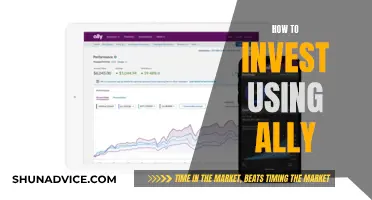
There are many options to consider when deciding where to invest 325,000 dollars. The best choice depends on the investor's risk tolerance, time horizon, knowledge of investing, financial situation, and how much they can invest. Here are some of the most common investment options:
- High-yield savings accounts: These accounts offer higher interest rates than traditional savings accounts, providing easy access to funds and relatively low risk.
- Long-term certificates of deposit (CDs): CDs are issued by banks and offer higher interest rates than savings accounts. Long-term CDs can be a good option when interest rates are expected to fall.
- Corporate bond funds: These funds invest in bonds issued by corporations and are suitable for investors seeking cash flow or those who want to reduce portfolio risk while earning a return.
- Dividend stock funds: Dividend stocks pay out a portion of the company's profits to shareholders, providing both long-term market appreciation and short-term cash payouts.
- Value stock funds: These funds invest in stocks that are bargain-priced relative to the market, offering the potential for significant returns but carrying higher risk.
- Small-cap stock funds: Small-cap funds invest in stocks of smaller companies with strong growth prospects, such as those in the tech industry.
- Real estate investment trusts (REITs): REITs offer high dividend payouts and the potential for capital appreciation, but prices can fluctuate with interest rate changes.
- S&P 500 index funds: These funds provide immediate diversification by investing in some of the largest and most successful American companies, offering higher returns but with more volatility.
- Nasdaq-100 index funds: Based on the Nasdaq's 100 largest companies, these funds offer exposure to major tech companies and the potential for high returns but come with significant volatility.
- Rental housing: Investing in rental properties can generate regular cash flow but requires active management and a long-term commitment.
- Treasury bonds: With interest rates expected to fall, investing in Treasury bonds can provide peace of mind during an economic recession, but the returns may not be substantial.
- Stocks: Investing in stocks allows individuals to buy into specific companies they believe in, but it requires a higher level of knowledge and carries more risk than some other options.
- Venture capital: Investing in private companies, particularly those in the artificial intelligence space, can be rewarding over the long term but requires a long-term commitment.
- Real estate: With interest rates coming down and real estate demand strengthening, investing in real estate funds or properties can be a smart move.
| Characteristics | Values |
|---|---|
| Investment Type | High-yield savings accounts, long-term certificates of deposit, long-term corporate bond funds, dividend stock funds, value stock funds, small-cap stock funds, real estate investment trusts, S&P 500 index funds, Nasdaq-100 index funds, rental housing, treasury bonds, stocks, venture capital, real estate, financial education |
| Investment Amount | $325,000 |
| Investment Time Horizon | Short-term, long-term |

Real estate
Buy REITs (Real Estate Investment Trusts)
REITs are companies that own and operate income-generating real estate, such as office buildings, retail spaces, apartments, and hotels. By investing in REITs, you can gain exposure to the real estate market without the hassle of owning physical property. REITs are traded on major exchanges, and you can purchase them through a brokerage account. They tend to pay high dividends, making them attractive for investors seeking regular income. The initial investment for REITs can be as low as $1,000, making it an accessible option for those looking to invest in real estate.
Invest in Rental Properties
Investing in rental properties is a traditional way to enter the real estate market. With $325,000, you can consider purchasing a residential or commercial property and renting it out to tenants. This strategy provides a steady cash flow and the potential for long-term capital appreciation. However, it also comes with responsibilities such as property management, maintenance, and covering expenses like mortgage payments and taxes. It is important to carefully evaluate the location and potential returns of the property to ensure a positive cash flow.
- Explore Real Estate Crowdfunding
- Consider Real Estate Partnerships
- Use an Online Real Estate Investing Platform
Online real estate investment platforms connect developers with investors. These platforms allow you to finance real estate projects through debt or equity investments. While these investments tend to be illiquid and speculative, they offer the potential for monthly or quarterly distributions. Keep in mind that some platforms are only open to accredited investors who meet certain income or net worth requirements.
Remember that investing in real estate comes with risks, and it is essential to conduct thorough research and due diligence before committing your funds. It is also advisable to consult with a financial professional to determine the best investment strategy for your specific circumstances and goals.
Cash Investments: What Are They?
You may want to see also

Stocks
There are two main ways to invest in stocks: by purchasing individual stocks or by investing in stock mutual funds or exchange-traded funds (ETFs). Mutual funds and ETFs allow you to buy small pieces of many different stocks in a single transaction, which helps to reduce your risk through diversification.
If you want to purchase individual stocks, you will need to do your research and choose companies that you believe have strong long-term growth potential. This approach can be time-consuming and requires a significant amount of knowledge about the stock market.
For most investors, mutual funds and ETFs are a better option. These funds are available within your 401(k), IRA, or any taxable brokerage account. An S&P 500 fund, which invests in about 500 of the largest US companies, is a good place to start.
When investing in stocks, it's important to focus on the long term and avoid compulsively checking how your stocks are doing on a daily basis. Stock market investments should be made with a long-term horizon in mind, ideally at least five years.
Additionally, it's crucial to only invest money that you won't need in the short term. This helps you avoid the temptation to sell your stocks during market downturns and ensures you don't lose money you might need for immediate expenses.
- S&P 500 Index Funds: These funds track the performance of the S&P 500 index, which consists of about 500 of the largest US companies. By investing in an S&P 500 fund, you effectively own small pieces of each of these companies, reducing your risk.
- Nasdaq-100 Index Funds: These funds are based on the Nasdaq-100 index, which includes some of the biggest and best tech companies, such as Apple and Alphabet. Nasdaq-100 index funds offer immediate diversification and have historically performed well, but they can also be volatile due to the high valuations of tech companies.
- Dividend Stock Funds: These funds invest in stocks that pay out dividends, which can provide a source of income in addition to potential capital gains. Dividend stocks are typically considered safer than growth stocks, but it's important to choose companies with a solid history of dividend increases rather than those with the highest current yield.
- Value Stock Funds: Value stock funds invest in stocks that are considered to be bargain-priced relative to the market. They can be a good option when stock valuations are high, as they provide the potential for capital appreciation when the market corrects. However, value stocks tend to have more volatility associated with them.
- Small-Cap Stock Funds: These funds invest in stocks of smaller companies, which often have strong growth prospects. Investing in small-cap funds can be riskier than investing in larger, more established companies, but it also offers the potential for higher returns.
When investing in stocks, it's important to remember that past performance does not guarantee future results. It's always a good idea to consult with a financial advisor to determine which types of stocks or funds are most suitable for your investment goals, risk tolerance, and time horizon.
Cash Flow and Investing: What's the Real Relationship?
You may want to see also

Venture capital
How to Invest in Venture Capital
There are several ways to invest in venture capital:
- Accredited investors: To qualify as an accredited investor, you must meet specific conditions, such as having a certain income level or net worth. Accredited investors can directly invest in venture capital funds and provide funding to up-and-coming businesses.
- Crowdfunding: The Jumpstart Our Business Startups Act of 2012 and its crowdfunding regulations allow non-accredited investors to invest in new companies. Equity crowdfunding platforms like Indiegogo and MicroVentures offer investment opportunities with minimum investments as low as $100.
- Investing in venture capital managers: Instead of investing directly in startups, you can invest in the companies that provide venture capital, such as Blackstone Group (BX), Carlyle Group (CG), and KKR. This approach offers diversification and allows you to benefit from the expertise of venture capital firms.
Things to Consider
When considering investing in venture capital, it is important to be aware of the risks and potential drawbacks. Here are some key points to keep in mind:
- Risk and return: Venture capital is a high-risk, high-reward investment strategy. While there is a possibility of significant gains, most VC-backed startups fail to return investors' capital.
- Limited liquidity: Investing in venture capital often requires a long-term commitment. Investors may need to wait several years to receive their principal investment, and in some cases, failed startups may result in zero investment returns.
- Creative control: Accepting venture capital funding may lead to a loss of creative control for the business owners. VC investors typically demand a large share of company equity and may exert influence over the company's management and direction.
- Due diligence: Conduct thorough research before investing. Analyze the business plan, the industry, the management team, and the company's operating history.
- Investment amount: Ensure that the investment amount is appropriate for the stage of the VC firm and the company's valuation. Consider the percentage of ownership you are implicitly asking for and whether it aligns with the typical range expected by VCs.
Cash Value Investing: Strategies for Long-Term Wealth Preservation
You may want to see also

High-yield savings accounts
- You can typically earn much higher interest rates at online banks than at national, brick-and-mortar banks.
- Savings accounts are highly liquid, and you can add money to the account. However, savings accounts typically only allow for up to six fee-free withdrawals or transfers per statement cycle.
- Watch out for banks that charge fees for maintaining the account or accessing ATMs.
- It's easy to find which banks offer the highest interest rates, and they are easy to set up.
- LendingClub Bank: 5.00% APY
- BrioDirect: 5.00% APY
- EverBank: 4.75% APY
- Bread Savings: 4.75% APY
- CIT Bank: 4.70% APY
- Bask Bank: 4.65% APY
- Popular Direct: 4.65% APY
- CIBC Bank USA: 4.61% APY
- TAB Bank: 4.52% APY
- UFB Direct: 4.31% APY
Best Places to Invest Your Cash Today
You may want to see also

Debt repayment
If you have $325,000 in cash, one option is to use it to pay off any existing debt. This can be a good strategy if you're looking to reduce your monthly outgoings and the interest you're paying over time.
The first step in any debt repayment strategy is to figure out exactly how much you owe, including the minimum monthly payments and interest rates on each debt. Next, calculate your monthly income and essential outgoings, such as rent, utilities, transport, food, and clothing. The money you have left over can be used to pay off your debts.
There are several different methods you can use to pay off your debts. Two of the most common are the snowball and avalanche strategies.
Snowball strategy
This method involves making minimum payments to all creditors while putting any extra money towards the account with the smallest balance. Once that debt is cleared, you take the money you were putting towards it and add it to the minimum payment of the next smallest debt. You continue this process until all your debts are paid off. The benefit of this strategy is that you get quick wins, which can be motivating. However, it can also be more costly since you're paying off smaller debts first while larger, higher-interest debts continue to grow.
Avalanche strategy
The avalanche strategy also involves making minimum payments to all creditors. However, with this method, you focus on paying off the debt with the highest interest rate first, then move on to the debt with the next-highest rate, and so on. This approach saves you money in the long run by getting rid of the most expensive debts first. However, it requires patience, especially if your high-interest debt is also one of your largest.
Other ways to pay off debt
As well as these two strategies, there are several other things you can do to help clear your debts:
- Take on a part-time job or start a side hustle to boost your income.
- Sell things you don't need.
- Consider debt consolidation by taking out a loan with a lower interest rate than your current debts and using it to pay them off.
- Negotiate with your lender to get a lower interest rate or adjust your payment schedule.
- Cut down on extraneous spending.
Cash Flow Notes: A Smart Investment Strategy
You may want to see also
Frequently asked questions
If you're looking to invest your money for the short term, you're probably looking for a safe place to put your cash before you need to access it in the near future. Some options include high-yield savings accounts, money market accounts, short-term corporate bond funds, and no-penalty certificates of deposit.
There are many options for long-term investments, including stocks, bonds, mutual funds, exchange-traded funds (ETFs), and real estate. It's important to consider your financial goals, risk tolerance, and time horizon before investing.
The first step to investing is opening a brokerage account. It's also important to do your research and understand the different types of investments available to you. You may also want to consider seeking advice from a financial professional.
It's important to remember that investing carries risk and there are no guarantees of returns. It's crucial to do your due diligence and understand the risks and potential rewards of any investment before committing your money. Diversification is also key to reducing risk and enhancing your long-term returns.







